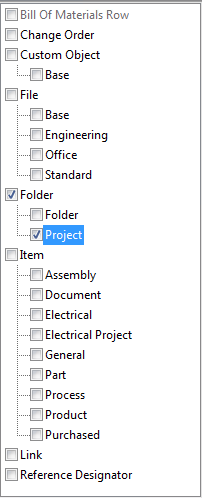User-Defined Property Associations
Associations define the entity classes that can use the user-defined property (UDP).
For example, if a UDP has an association of Change Order, then only change orders can use that UDP.
A UDP can also be associated with specific entity sub-classes. For example, a UDP can be created so that only Folders of type Project are able to use that UDP.

If a new UDP is not associated with any entity classes, it will not appear in the properties grid for that entity.
Association | Description |
|---|---|
Bill of Materials Row | Use the Bills of Material (BOM) Row association to create a custom BOM row property. |
Change Order | Use the change order association to create a custom change order property. |
Custom Object | Use the custom object association to create a custom object property. The custom property may be restricted to a certain category type, such as Base. |
File | Use the file property association to create a custom file property. The custom property may be restricted to files of a certain category type, such as Base or Engineering. |
Folder | Use the folder association to create a custom folder property. The custom property may be restricted to a folder sub-class, such as a basic folder or project. |
Item | Use the item association to create a custom item property. The custom property may be restricted to certain types of item sub-classes, such as a part or a document. |
Link |
The Link association is used to create a custom object link property to track link data between a custom object and another entity class. Imported Factory property links show this link association as selected. |
Reference Designator | A reference designator is a property that makes it easier for electrical users to view a BOM by indicating how an item is tagged, its location, or its installation information. Use the reference designator association to create a custom reference designator property that can be displayed in the Reference Designator View. |